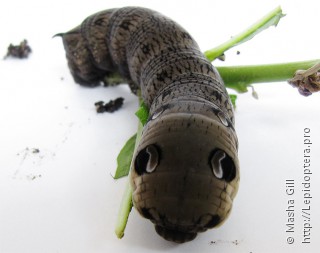Caterpillars in the garden — friends or enemies?
Community and Forum → Blog → Caterpillars in the garden — friends or enemies?
Lev Bely, 30.07.2012 19:15

Those who do love to work in the garden or grow plants on a balcony, for to enjoy seasonally with a cheery, vivid greenery, sooner or later have to deal with some kind of a pest. The latter, as a rule, vexatiously damages the best and abundantly flowering plant.
Thus we're usually afraid of any insect on the spot and, having met one, start hurriedly elaborating war plans, not even considering that certain insects could turn out to be rather useful.
Caterpillars are of the special, serious attention. Vigorously munching on fresh greenery, they are able to “clean up” an entire row in half a day. Odd as it may seem, not all of them deserve to be eliminated. Some won't seriously harm your garden, instead, they can suit it well. So the thing is that to distinguish “enemies” from “friends” and to get to know how to control voracious eaters.
The caterpillar is commonly called an “eating” stage of a butterfly's life cycle, when what will eventually turn into butterfly/moth, now keeps chewing on green leaves and sprouts in order to rapidly get bigger and finally pupate. To get an imago stage, that is an adult butterfly/moth, it passes through few stages during its life — egg, larva/caterpillar and pupa.
Anyway, let's go back to our garden and take a look, for instance, at the beautiful White-lined sphinx moth (Hyles lineata), which is often mistaken for a hummingbird. When feeding, it hovers over a flower quickly flapping its wings, rolls out its long proboscis and puts it into the nectarines. H. lineata caterpillars are quite large, they could reach as adult nearly 8cm in length; usually green, but rarely black can be also met. White-lined sphinx caterpillars, as well as ones of other species, surely, feed on leaves. Yet they so rarely happen to appear in as such numbers as to be really devastating to plants. So is it really every single of them worth eliminating?
Sterile garden seems to be kind of deviance. As caterpillar rises its head up, we immediately rush spraying whatsoever alive. To evaluate if your garden does need serious treatment, first of all it's advised to identify caterpillars with some identification guide such as www.butterfliesandmoths.org/identification_tools, or any other of the kind.
Now look at them and your plants. Do they harm that much? If not, let them alone, what actually won't last long since soon they'll pupate and cause no damage more. Seems that they're keen on eating your tomato-winner of the last Tomato Games? Just move them carefully to a less valuable plant and make sure that they feed on it.
In case when caterpillars badly damage your crops or deform ornamental plants, there are at least two non-chemical methods to use. The soil bacterium Bacillus thuringiensi, or BT, is toxic to caterpillars whilst safe for most other insects, animals and humans. Note that BT concentrate will kill all the caterpillars in your garden including those which do not cause measurable damage. The second method could go well when you want to remove only most voracious guests. Take caterpillars off the plant and put them into a bucket with a soapy water. Thus you'll make sure “enemies” are off while “friends” peacefully munching somewhere aside and so happy with that.
Alexandria Echo Press, http://www.echopress.com
Photo: Elephant Hawk-moth (Deilephila elpenor) caterpillar
All the rest posts on: Q&A, Pests, how to
Comments
New comment
Note: you should have a Insecta.pro account to upload new topics and comments. Please, create an account or log in to add comments.
* Our website is multilingual. Some comments have been translated from other languages.
Random species of the website catalog
News
- 31.12.2024: Если нужно загрузить на сайт много фотографий
- 10.12.2024: Новое поле в «Поиске энтомологов»
- 05.12.2024: Insecta.pro maps: filter by taxon
New photos (22.02.2025)
Fresh from the community
- 10:56, P. Khramov: / → Pyrgus malvae / Nikolay Greb...
- 10:55, P. Khramov: Not identified → Lasiocampa quercus...
- 7:37, N. Grebennikov: Lasiocampa quercus....
Popular insects
Recommended blog topics
- ICZN Election of Commissioners
- A. Gordon, O. Gorbunov, V. Murzin on Russian TV in 2004
- The insects exhibition in Kotlas
- Ships in Maritimes are being searched for invasive moth



























